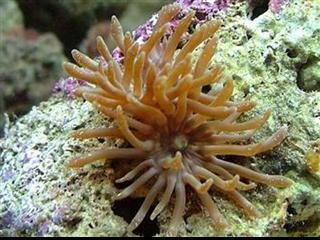Majano anemones (Anemonia spp.) are often mistaken for harmless decorative polyps by new hobbyists—but make no mistake, they’re pests. Although more visually appealing than Aiptasia, Majanos can spread rapidly, sting corals, and take over rockwork if left unchecked.
What Are Majano Anemones?
Majano anemones are small, photosynthetic anemones that resemble mini bubble-tip or Ricordea anemones. They usually have greenish-brown bodies with short, bubble-tipped tentacles that give them a deceptively attractive appearance.
Unlike ornamental anemones, Majanos:
- Multiply aggressively through budding or pedal laceration
- Sting neighboring corals, leading to tissue recession
- Compete for light and nutrients with prized corals
They often start as a single hitchhiker and, like Aiptasia, can become a widespread nuisance.
How to Identify Majano Anemones:
- Green, brown, or tan body with short, stubby tentacles
- Bubble-like tips, often greenish or iridescent
- Small (0.5–3 cm) and typically attached to rock, plugs, or back glass
- Often found in clusters once established
They don’t retract as quickly as Aiptasia and tend to spread in more open areas.
Why They’re a Problem:
- Sting and damage corals via allelopathy and physical contact
- Spread rapidly, especially in nutrient-rich tanks
- Resistant to casual removal, regrow from tissue fragments
Methods of Control:
1. Chemical Spot Treatments
- Aiptasia-X and Joe’s Juice can be used similarly to treat Majanos
- Kalkwasser paste (carefully applied) also works
- Target when the anemone is open and extended for maximum effect
2. Manual Removal (Use with Caution)
- Scraping or chipping off with a scalpel may help—but fragments can regrow
- Consider combining with chemical treatment immediately after physical removal
3. Natural Predators (Unreliable)
- Some anecdotal success with:
- Acreichthys tomentosus (Matt’s Filefish)
- Certain Butterflyfish (but these are often coral nippers)
Predator reliability is inconsistent, and these fish may also nip at desirable corals.
Prevention:
- Inspect and dip all incoming rock and frag plugs
- Quarantine coral and rock when possible
- Don’t overlook “just one” anemone—treat immediately
Final Thoughts:
Majano anemones might look harmless—or even pretty—but they’re opportunistic pests that can become a major nuisance. Treat them like you would Aiptasia: early, aggressively, and with the understanding that fragments left behind can make things worse. A reef tank should showcase your corals—not a field of glowing green intruders.
